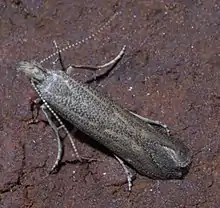Isophrictis similiella
Isophrictis similiella is a moth of the family Gelechiidae. It was described by Vactor Tousey Chambers in 1872. It is found in North America, where it has been recorded from Kentucky, Arkansas, Illinois, Indiana, Maine, Manitoba, Massachusetts, Oklahoma, Pennsylvania, Saskatchewan and Texas.[1][2]
| Isophrictis similiella | |
|---|---|
 | |
| Isophrictis similiella (possibly Isophrictis magnella) | |
| Scientific classification | |
| Domain: | Eukaryota |
| Kingdom: | Animalia |
| Phylum: | Arthropoda |
| Class: | Insecta |
| Order: | Lepidoptera |
| Family: | Gelechiidae |
| Genus: | Isophrictis |
| Species: | I. similiella |
| Binomial name | |
| Isophrictis similiella (Chambers, 1872) | |
| Synonyms | |
| |

Isophrictis similiella (possibly Isophrictis magnella), Size: 8.6 mm

Isophrictis similiella (possibly Isophrictis magnella)
The wingspan is about 11 mm.
The larvae bore in the receptacle of Solanum carolinense and the flowerheads of Rudbeckia hirta. They burrow down the stem up to three inches to pupate, chewing an exit hole before pupating.[3]
References
- Savela, Markku. "Isophrictis Meyrick, 1917". Lepidoptera and Some Other Life Forms. Retrieved October 28, 2017.
- Moth Photographers Group at Mississippi State University
- Bug Guide
This article is issued from Wikipedia. The text is licensed under Creative Commons - Attribution - Sharealike. Additional terms may apply for the media files.